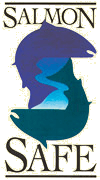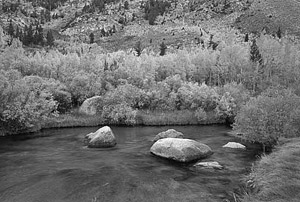Salmon-Safe eco-label gains momentum
by Larry Nussbaum
This article was originally published in February 2006

(February 2006) — A new eco-label is appearing in PCC stores and around Puget Sound. It’s the “Salmon-Safe” seal of approval and it indicates that an independent third-party certifies a farmer is farming in a fish-friendly way, protecting water quality and habitat for salmon.
Farmers play a critical role in restoring native salmon runs because the major salmon streams flow through the most productive agricultural valleys. Salmon need clean, cool rivers to spawn, reproduce and survive.
But erosion and runoff from poorly managed farms can bring silt into spawning habitats, covering a stream’s gravel where salmon eggs hide and leaving unhatched eggs exposed to dangers they cannot survive. Toxic chemicals from farms can seep into rivers, harming young fish. Excessive irrigation depletes water levels.
The Salmon-Safe guidelines require using natural methods to control weeds and pests. Cover cropping in fallow fields, for instance, prevents erosion. Efficient water use and irrigation practices protect water levels. Planting trees along streams stabilizes the banks, keeps streams shaded and provides habitat structures.
The program also addresses animal management and encourages practices that enhance biodiversity on the farm. Specialists in farming and fisheries conduct the assessments for certification.
Twenty-two farms in the Puget Sound region have been Salmon-Safe certified in the past year and a half. They include operations in the Snoqualmie, Skykomish, Nisqually, Nooksack, Hood Canal, Dungeness and Skagit watersheds.

PCC Natural Markets began labeling produce last fall from participating Salmon-Safe farms and is encouraging growers to participate. Nash’s Organic Produce and Andrew Stout’s Full Circle Farm were among the first to be certified. Nearly a dozen items in PCC’s produce section now feature the Salmon-Safe label. As the weather warms, you’re likely to see it on more local produce.
Native salmon have been an integral part of the culture, ecology and economy of the Pacific Northwest, long before Europeans settled here. Today, they remain an icon of the region’s quality of life. But many native salmon species are in severe danger because of the cumulative effects of development, dams, irrigation, flood control, habitat fragmentation, and land use policies in forestry and agriculture.
Several species, such as the Puget Sound Chinook, are listed as “threatened” under the federal Endangered Species Act. The Puget Sound Chinook is not to be confused with the salmon we commonly eat, most of which comes from still healthy fisheries in Alaska and coastal Washington and Oregon.
The Salmon-Safe program was started in Oregon in the late 1990s where it has proved to be a successful promotional strategy for salmon-friendly practices in a variety of agricultural sectors, including wine, fruit, dairy and produce.
The Seattle-based Stewardship Partners, a non-profit organization that works with private landowners to preserve the environment, is promoting the program in Washington to support restoration projects and conservation practices among farmers throughout the region.
Look for the Salmon-Safe label and be sure to thank the farmers for doing their part to help protect our region’s native salmon.
